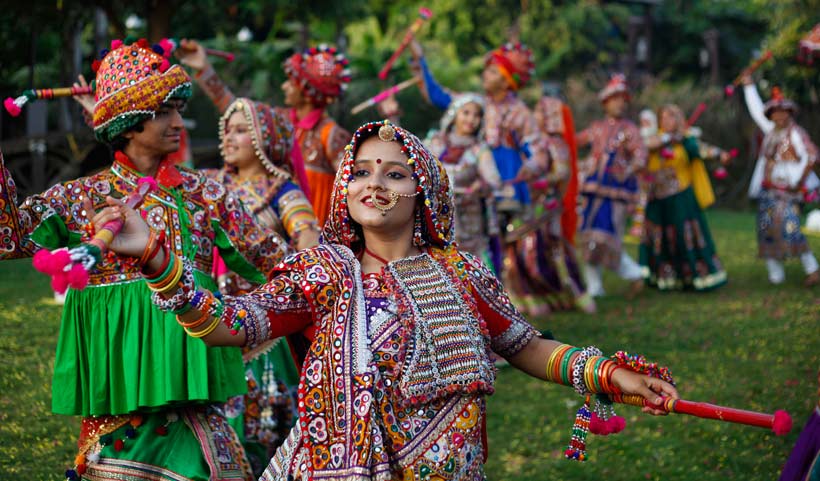Navratri

Festival of Navratri is full of lights, joy and festivity. Hindus celebrate this with devotion and enthusiasm throughout India. The celebration is carried on for ten days and the last four days are very important. Navratri means nine nights and so the tenth day Goddess Durga, who is worshipped throughout the nine days, is immersed in holy water after pooja. Each and everyday has its importance and meaning. People worship Goddess in three forms and try to enhance their physical, mental and spiritual practice in these nine days.
Navaratri is a festival dedicated to the worship of the Hindu deity Durga. The word Navaratri means 'nine nights' in Sanskrit, nava meaning nine and ratri meaning nights. During these nine nights and ten days, nine forms of Devi are worshipped. The tenth day is commonly referred to as Vijayadashami or "Dussehra" (also spelled Dasera). Navaratri is an important major festival and is celebrated all over India and Nepal. Diwali the festival of lights is celebrated twenty days after Dasera. Though there are in total five types of Navaratri that come in a year, Sharad Navaratri is the most popular one. Hence, the term Navaratri is being used for Sharada Navaratri here.
Navratri festival is celebrated twice a year, though the one that is celebrated in September or October is well-known and celebrated with extreme passion and fervour. Some Hindus believe that every night one form of Goddess is worshipped while some believe that three forms of Goddess are worshipped and they are the trinity of God. The celebration varies from one state to another although the dedication and devotion remains the same all over India.

Navratri Celebration and Fasting
Some people eat only fruits and drink milk during the entire nine days and nights.
Some eat meal one time a day and that meal should be satvik, which means vegetarian meal which is prepared without the use of onion and garlic.
Fasting is not compulsory and even after few years if the devotee feels that he or she is not capable of continuing fast during Navratri, he or she can discontinue also.
It is good to keep mind, body and thoughts pure during the time of Navratri.
If possible try to light a Jyot in front of Goddess Durga's statue or at least a picture throughout the nine days and nights.
Start the prayers with praying for Lord Ganesha and then perform aarti in front of Goddess Durga.
Men do not shave or cut their hair during this period.
People do not wear black clothes during this period and avoid keeping leather goods with them.
People worship young girls and feed them with sweets and different types of traditional and delicious food items. They consider them as form of Goddess Durga.
Since it is believed that Goddess is fond of red flowers and red colour, women and young girls prefer wearing clothes in red and yellow colour.

Fasting commences on the ninth night of Navratri.
People pray to Goddess Durga to destroy the evil during Navratri. They ask help and strength from the Goddess to fight against the evil and protect the Hindu dharma. In West Bengal, men and women celebrate Navratri festival as Durga Pooja and worship huge idols of Goddess Durga. In Gujarat people perform traditional dance which is known as Garba almost throughout the night. They wear colourful dresses and mostly Indian traditional dresses are preferred.
Chaitra Navratri is celebrated after Holi and during Chaitra Shukla Paksha. This starts from the first day and ends on the ninth day which is also celebrated as Ram Navmi. The worship of Goddess on the eighth day is very important and auspicious and is significant in both Navratri festivals.
Dussehra or Navratri is also celebrated as Lord Rama's victory over the Demon king Ravana. He was the ten headed king of Lanka and had kidnapped Rama's wife, Sita. The main objective is, however, to celebrate the victory of good over the evil.
Nine forms of Shakti are worshipped during the Navaratris. The Devis worshipped depend on the tradition of the region.
In Western India, particularly in the state of Gujarat and Mumbai, Navaratri is celebrated with the famous Garba and Dandiya Raas dance. Since the past few years, the Government of Gujarat has been organising the "Navaratri Festival Celebrations" on a regular basis for the nine days of Navaratri Festival in Gujarat. People from all over Gujarat and even abroad come to participate in the nine-day celebration. It is also popular throughout India and among Indian communities around the world including the UK, Canada, Malaysia, Singapore and USA.

Durga
Kali
Amba or Jagadamba, Mother of the universe
Annapoorna devi or Gauri, The one who bestows grains (anna) in plenty (purna: used as subjective)
Sarvamangala or Sheetal, The one who gives happiness (mangal) to all (sarva)
Bhairavi
Chandika or Chandi
Lalita
Bhavani
Mookambika or Tara
No comments:
Post a Comment